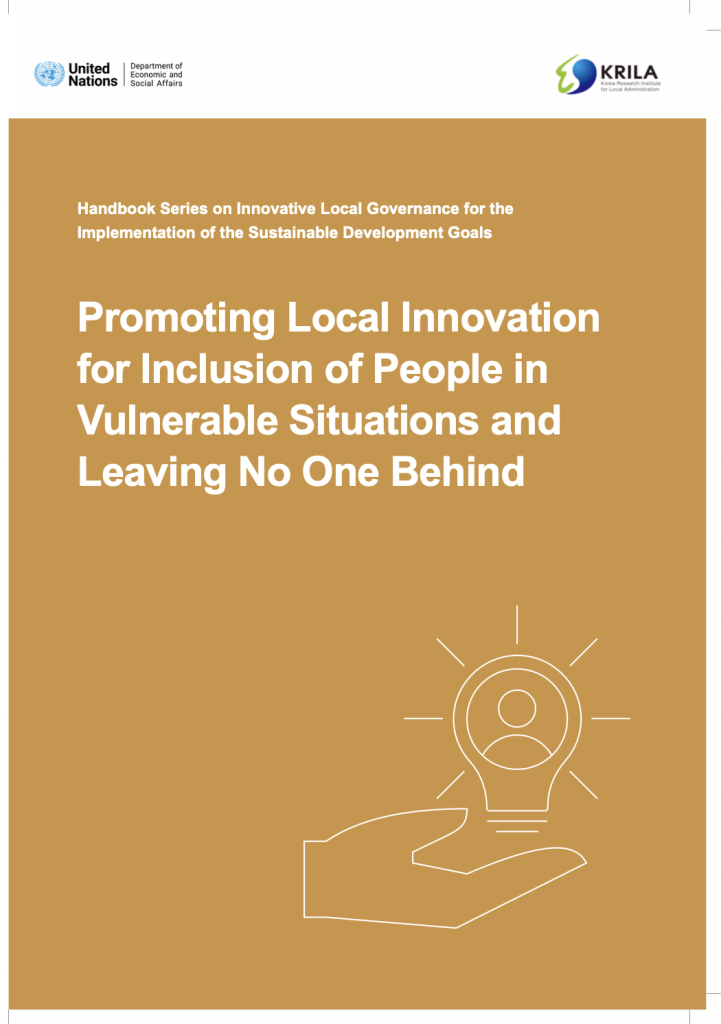This handbook focuses on promoting and harnessing innovation to foster social inclusion of people in vulnerable situations and the principle of leaving no one behind for local governance. It introduces innovative approaches, strategies, practices, and tools and people-centred actions to mitigate social vulnerabilities and achieve the SDGs.
The handbook is divided into two parts:
Part I. The critical role of local governance in promoting innovation for social inclusion: Part I provides an overview on the key concepts and main challenges and introduces the dynamic relationships of major buildingblocks in local governance innovation for social inclusion: People, Vision, Strategy, Governance, Process, Partnerships, Technology and Monitoring and Evaluation. Those building blocks are aimed at influencing public policies, societal attitudes and socio-political processes that enable and empower marginalized populations. Part I also includes a self-assessment exercise that serves as the overall framework and a guidance tool for the rest of the handbook.
Part II is comprised of five thematic chapters:
Chapter 1. Strengthening Inclusive and Participatory Governance for Engagement of People in Vulnerable Situations in Local Policy Processes: Chapter 1 explores existing challenges and innovative strategies, approaches and cases in the field. This chapter highlights the significance of choosing the proper mix of approaches to communicate information and leverage direct and multi-channel dialogues. It proposes a set of organized actions to promote innovation through inclusive participatory governance using the dynamic relationships of the building blocks framework and concludes with a practical assignment and key takeaways.
Chapter 2. Providing Inclusive Local Public Services: Chapter 2 introduces the pathway to the delivery of local public services for all. This chapter provides an overview of a variety of services for which innovative local governments assume primary responsibilities in addressing inequality gaps, followed by innovative strategies, approaches and a set of organized actions aimed to ensure inclusive local public services. The chapter highlights that the ongoing design of public services is a collaborative process involving co-designing and co-creation between service providers and users.
Chapter 3. Leveraging ICTs and Digital Government for Inclusion and Empowerment of People in Vulnerable Situations: Chapter 3 presents how ICTs and digital government can be leveraged to promote inclusive and participatory governance, inclusive public service delivery and empowerment of vulnerable People. Chapter also addresses the major challenges in bridging the digital divide in all forms and proposes strategies and approaches for promoting education, information, technology and know-how while developing equitable ICT infrastructure, assistive technologies and support systems that are inclusive by design.
Chapter 4. Fostering Innovative Partnerships for Inclusion of Groups in Vulnerable Situations at the Local Level: Chapter 4 sets forth the various incentives that drive partnerships, including the overall benefits of Public-Private-People -Partnerships (PPPPs). This chapter proposes strategies and approaches for such partnerships, including the creation of specialized platforms and redefining the role of the private sector and citizens in social innovation.
Chapter 5. Building Inclusive Mindsets and Developing Capacities of Local Government Officials and Other Stakeholders: Chapter 5 proposes a variety of innovative methods to foster inclusive mindsets as well as capacities and competencies at individual, organizational, institutional and societal levels.
Summary and Recommendations: The handbook concludes with key takeaways highlighting the importance of the holistic approach to mainstreaming inclusion throughout the dynamic relationships of all eight building blocks to ensure that social inclusion materializes in local governance.
Promoting Local Innovation for Inclusion of People in Vulnerable Situations.pdf





